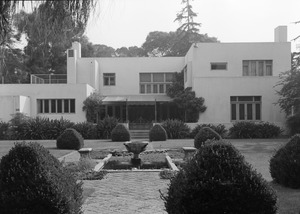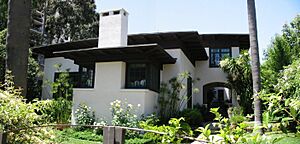Irving Gill facts for kids
Quick facts for kids
Irving John Gill
|
|
|---|---|
 |
|
| Born | April 26, 1870 |
| Died | October 7, 1936 (aged 66) |
| Nationality | American |
| Occupation | Architect |
| Spouse(s) | Marion Waugh Brashears |
| Buildings |
|
Irving John Gill (born April 26, 1870 – died October 7, 1936) was an American architect. He is known for his work in Southern California, especially in San Diego and Los Angeles. Many people see him as a leader in the modern architecture movement.
Twelve of his buildings are listed on the National Register of Historic Places. This means they are important historical sites. Many other buildings he designed are also recognized as historic by local governments.
Contents
Early Life and Training
Irving Gill was born on April 26, 1870, in Tully, New York. His father, Joseph Gill, was a farmer and later a carpenter. As a child, Irving went to school in Syracuse, New York.
In 1889, Gill started working as a draftsman in Syracuse. A draftsman draws detailed plans for buildings. In 1890, he moved to Chicago to work with Joseph Lyman Silsbee.
Then, in 1891, Gill joined the famous firm of Adler and Sullivan. He worked alongside other important architects like Frank Lloyd Wright. While there, he helped design the Transportation Building for the 1893 Chicago World's Fair. In 1893, he moved to San Diego to start his own architecture business.
Building a Career in San Diego
After moving to San Diego, Irving Gill's health improved. He began his own architectural practice. In 1894, he teamed up with Joseph Falkenham. Their firm was called "Falkenham & Gill, the Architects." They worked on several projects, including large commercial buildings.
When Falkenham left San Diego in 1895, Gill started taking on big home projects. He designed homes for important people in San Diego. He also worked on Granger Hall for a local musician named Ralph Granger.
In the late 1890s, Gill began using more concrete in his designs. His work helped show how useful concrete could be for future buildings.
Partnerships and New Styles
In 1896, Gill formed a partnership with William S. Hebbard. Their firm, Hebbard & Gill, became known for two styles: Tudor Revival and Prairie School. Their most famous project was the George W. Marston House, which is now a museum.
During this time, Gill also trained Hazel Wood Waterman. She helped design houses near Balboa Park. Waterman later became a successful architect with her own practice.
In 1901, California started requiring architects to have a certificate. Gill automatically received one because he was already working as an architect.
In 1907, Gill's partnership with Hebbard ended. Soon after, Gill partnered with Frank Mead for about seven months. They completed a few houses together.
Modern Designs and Innovations
In 1908, Gill designed the Broadway Fountain, also known as the Electric Fountain. It was built in the center of Horton Plaza Park in Downtown San Diego. This fountain was special because it was one of the first in the country to combine water and colored electric lights.
In 1911, Gill's nephew, Louis John Gill, joined his firm. That same year, Gill worked with Bertram Goodhue on the Panama–California Exposition (1915). He helped design the Balboa Park Administration Building. Today, this building is known as the Gill Administration Building of the San Diego Museum of Man.
In 1913, Ellen Browning Scripps asked Gill to design the La Jolla Woman's Club. For this building, he used a special "tilt-slab" technique. Large concrete walls were poured flat on the ground and then tilted up into place. This was one of the first buildings in California to use this method. In 1914, his nephew Louis became his partner.
Later, Gill moved to Los Angeles County. He designed many buildings for the new city of Torrance, California. In the 1920s, he returned to North San Diego County. His work slowed down because he was often ill. Also, people's tastes in architecture were changing.
In the late 1920s, Gill designed several public buildings for Oceanside, California. This was his last big project. His final work was designing homes for Native American families. These families settled at the Rancho Barona Indian Reservation.
Why Irving Gill Was Important
Irving Gill cared about how good architecture could help people. He designed buildings for everyone, from bankers to Native American families. He also designed for an African American church and Mexican workers.
Historians say Gill's architecture was a "new beginning." It was different from older styles. His work was sometimes called "cubist" because of its simple, geometric shapes.
Gill's buildings had simple interiors. He removed unnecessary details to save money and make them easy to clean. His homes often had smooth walls, simple fireplaces, and lots of skylights. They used concrete floors and avoided too many dividing lines. This made them feel clean and open.
His best work, mostly from the 1910s, featured flat roofs without overhangs. He often used one main material, usually concrete. His buildings had casement windows and white walls. They were often shaped like cubes or rectangles. Many also had arches, like those found in old California missions.
Some of his most famous buildings still in use today include:
- The Ellen Browning Scripps residence (now the Museum of Contemporary Art San Diego)
- The earliest buildings at The Bishop's School
- The La Jolla Woman's Club
- The La Jolla Recreation Center
- The George W. Marston House
He designed ten churches. The Christian Science Church in San Diego is one of the best known. The Woman's Club and Marston House are listed on the National Register of Historic Places.
After his death, Gill's work was not as well-known for a while. But a book called Five California Architects published in 1960 helped bring attention back to his designs. Today, Irving Gill is recognized as a very important figure in modern architecture.
Personal Life
On May 28, 1928, when he was 58 years old, Irving Gill got married for the first and only time. His wife was Marion Waugh Brashears. Letters written by Gill show that he cared deeply for his wife. He died on October 7, 1936, at his wife's family ranch in Carlsbad, California.
Works
Here are some of the buildings designed by Irving Gill:
- Maj. Myles Moylan House, San Diego, 1894 (with Joseph Falkenham)
- Granger Hall, National City, 1898
- Wildacre, Newport, RI, 1901
- Sunnyslope Lodge, San Diego, 1902
- George W. Marston House, San Diego, 1904–05
- Alice Lee House, San Diego, 1905–06
- Katherine Teats House, San Diego, 1906
- Burnham-Marston House, San Diego, 1907 (with William Sterling Hebbard)
- Old Scripps Building, San Diego, 1908
- Cossitt Cottages, San Diego, 1910
- Horton Plaza Fountain, San Diego, 1909
- F. B. Lewis Courts (aka Bella Vista Terrace), Sierra Madre, 1910
- First Church of Christ, Scientist, San Diego, 1909-1910
- Miltimore House, South Pasadena, 1911
- Administration Building for the Panama California Exposition, now called the Gill Auditorium, San Diego, 1912
- La Jolla Woman's Club, San Diego, 1912
- Earliest buildings at The Bishop's School, San Diego, 1912
- Ellen Browning Scripps residence, now the Museum of Contemporary Art San Diego, San Diego, 1913
- Pacific Electric Railroad Bridge, Torrance, 1913
- Etiwanda Depot, Rancho Cucamonga, California, 1914
- La Jolla Recreational Center, San Diego, 1915
- Walter L. Dodge House, West Hollywood, 1916 (destroyed 1970)
- Samuel Raymond House, Bluff Park, Long Beach, 1918
- Clarke Estate, Santa Fe Springs, 1919
- Horatio West Court, Santa Monica, 1919
- Americanization School, Oceanside, 1931
- Oceanside City Hall and Fire Station, Oceanside, 1934
See also
 In Spanish: Irving Gill para niños
In Spanish: Irving Gill para niños



